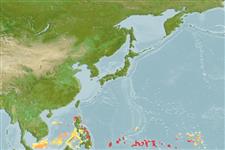>
Acanthuriformes (Surgeonfishes) >
Chaetodontidae (Butterflyfishes)
Etymology: Chaetodon: Greek, chaite = hair + Greek, odous = teeth (Ref. 45335).
Eponymy: Dr Warren E Burgess is an American ichthyologist and research scientist who co-wrote: Dr Burgess’s Atlas of Marine Aquarium Fishes (1988) and the Colored Atlas of Miniature Catfish (1992). [...] (Ref. 128868), visit book page.
Environment: milieu / climate zone / depth range / distribution range
Ecologie
marien rifbewoner; diepte 20 - 130 m (Ref. 90102). Tropical; 19°N - 6°N
Western Pacific: Philippines and northeastern Borneo to Flores and Pohnpei. Recently reported from Tonga (Ref. 53797).
Grootte / Gewicht / Leeftijd
Maturity: Lm ? range ? - ? cm
Max length : 14.0 cm TL mannelijk / geslacht onbekend; (Ref. 9710)
Dorsale stekels (totaal) : 13; Dorsale zachte stralen (totaal) : 18 - 19; Anale stekels: 3; Anale zachte stralen: 15 - 16. Body is white with broad diagonal black stripes across the body, the first from the origin of the first dorsal spine to the soft portion of the anal fin, the second from just anterior of the dorsal fin extending postero-ventrally ending at about the level of the pectoral fin, and the third running vertically across the eye from the forehead (Ref. 4855). Snout length 2.8-3.0 in HL. Body depth 1.6-1.7 in SL (Ref. 90102).
Occur in drop-offs where gorgonians and black corals are abundant. Usually in depths over 40 m, but in some localities much shallower (Ref. 48636); usually in depths less than 40 m in East Indian region, solitarily or in pairs (Ref 90102). Reported to have been collected from a depth of 380 feet (= 115.8 m) in Palau (J.C. Delbeek, CAS, pers.comm. 10/2017) . Oviparous (Ref. 205). Form pairs during breeding (Ref. 205). They do well in the aquarium and are exported from the Philippines (Ref. 37816). Maximum depth reported taken from Ref. 128797.
Levenscyclus en paargedrag
Maturiteit | Voortplanting | Paaien | Eieren | Fecunditeit | Larven
Form pairs during breeding (Ref. 205).
Myers, R.F., 1991. Micronesian reef fishes. Second Ed. Coral Graphics, Barrigada, Guam. 298 p. (Ref. 1602)
Status op de Rode Lijst van het IUCN (Ref. 130435: Version 2024-1)
Gevaar voor de mens
Harmless
Gebruik door de mens
Visserij: commercieel; Aquarium: Commercieel
Tools
Speciale rapporten
Download XML
Internetbronnen
Estimates based on models
Preferred temperature (Ref.
123201): 25.7 - 28.7, mean 28 °C (based on 13 cells).
Fylogenetische diversiteitsindex (Ref.
82804): PD
50 = 0.5000 [Uniqueness, from 0.5 = low to 2.0 = high].
Bayesian length-weight: a=0.02291 (0.01133 - 0.04632), b=3.00 (2.83 - 3.17), in cm total length, based on LWR estimates for this Genus-body shape (Ref.
93245).
Trofisch niveau (Ref.
69278): 3.5 ±0.37 se; based on food items.
Weerstandsvermogen (Ref.
120179): Hoog, minimale populatieverdubbelingstijd minder dan 15 maanden (Preliminary K or Fecundity.).
Fishing Vulnerability (Ref.
59153): Low vulnerability (10 of 100).
